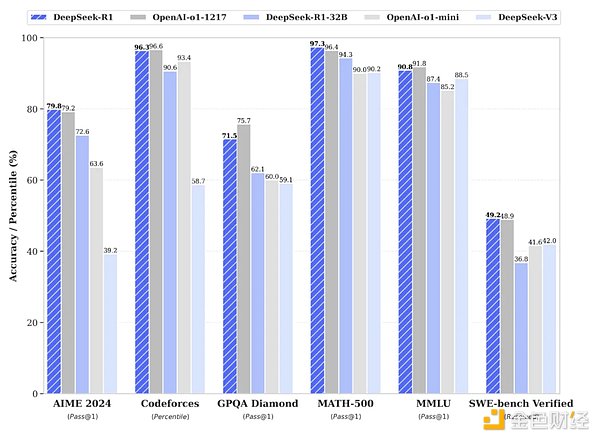
Author: Paul Veradittakit Source: VeradiVerdict Translation: Shan Oppa, Golden Finance
DeepSeek Originally High- A sub-project of Flyer hedge funds, launched by several thousand Nvidia GPUs. The DeepSeek R1 cost over $1 billion and used 2,000 Nvidia H800GPUs and took 55 days to beat OpenAI’s benchmark for the o1 model, which required hundreds of billions of dollars and over 16,000 advanced GPUs to develop, shocked the world.
DeepSeek R1 has 671 billion parameters, while GPT-4 has 1.76 trillion parameters. Large models of OpenAI may require thousands of GPUs for training and high-end clusters for inference, while DeepSeek 7B and 67B can run on consumer-grade hardware (a handful of A100s or H100s).
DeepSeek-R1 and competitors
In response, Nvidia's share price fell 18% (a loss of $600 billion in market capitalization). The old idea that AI models must be closed source and computationally expensive to succeed is collapsing.
Existing decentralized artificial intelligence narrativeUnlock the mystery of the Crypto x AI stackAI x Crypto project believes that crowdsourcing, public, and decentralized AI will eventually create better models than centralized AI.
That's not the case, as the highest performing models come from closed-source companies such as OpenAI and Anthropic. Crypto x AI companies have adapted to this situation, focusing on infrastructure rather than model building.
For example, GPU markets such as Akash, Render, IoNet and Exabits have achieved sustainable revenue. Companies that allow users to share network bandwidth(such as Grass and Gradient) have found their own niche, which is to provide distributed network crawling services to web2 customers. Storage networks such as Arweave, Filecoin and Ocean have also achieved good results as they become the building platforms for these projects. Supply networks are thriving because they can tailor cheaper and more scalable services for off-chain customers.
Messari Report on DePin and AI x Crypto
Now, GPUs and financial resources are no longer limits to creating high-quality AI models, web3 AI companies can focus on replicating the effectiveness of DeepSeek while providing modality, user ownership, censorship resistance, privacy and other new advantages.
Pantera provides funds to companies such as SaharaAI and Sentient, which believe that these companies can meet or exceed the performance of traditional AI companies while maintaining competition by providing other services force.
For example, Sahara AI is building a platform where anyone can monetize AI models, datasets, and applications in a collaborative space. Users can manually train models without permission, provide training data, and use codeless tools to create customized AI models. They can only meet the needs of all these stakeholders (AI developers, users, resource providers) because everything is closely related to their native Sahara blockchain.
The future of artificial intelligence will be built by Web3 infrastructure. DeepSeek has proven that high-performance AI models do not have to be built in closed source, nor do they have to bear the computational cost. I'm very happy to see an AI model developed next year using the full web3 AI stack.I believe that supply-side projects will continue to grow, and consumer-oriented projects can leverage their ability to build networks that invite community participation to start competing with web2 competitors . For example, users are willing to register to train web3 models and actively try these models through hackathons and funding programs.
In the near future, I believe that the best performing AI model will be built onOn the chain.












